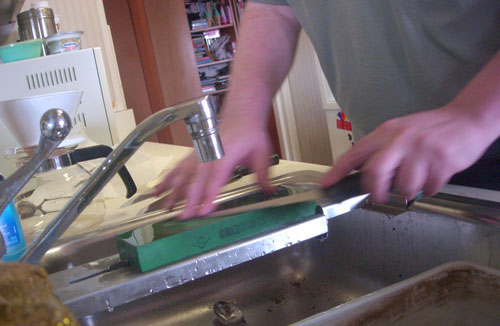|
|
05/18/2010 |
 Okay, I admit it, that bit on experts not wanting you to know was an exaggeration (actually an outright lie), but here are four tips on sharpening knives that you might not know. Okay, I admit it, that bit on experts not wanting you to know was an exaggeration (actually an outright lie), but here are four tips on sharpening knives that you might not know.
1) Consistency. I don't know exactly what angle I sharpen things at but I can tell you the first time I sharpen anything I have to go to a pretty coarse grit to establish a consistent bevel. Then it's cake. The next time I sharpen the same tool it doesn't matter because I naturally work at the same angle each time and the knife will have been already prepped, so my actual time resharpening is pretty small and people think I'm really fast and think they are doing something wrong because they are so slow in comparison. All I am doing is being naturally consistent - which anyone can do if they just practice and relax.
2) Use the non-flat parts of the stone. A customer from Japan came into my shop to test sharpening stones. I lent him my set of Chosera Stones to try out. He immediately noticed that my stones weren't particularity flat - not horrible but not flat. He did not berate me for sloppiness he just sharpened on the ends of the stone that were flat and about ten minutes later the entire stone was pretty flat and he was able to take longer and longer strokes. (He ended up getting the Choseras). What I learned from him is that if I pay attention to the stone I can save time flattening, and save wear and tear on the stone.
3) Don't go to too high a grit. I used to sharpen everything to the highest grit stone I had. No more. With woodworking tools a high grit can be a good thing but with kitchen knives you might find a coarser grit works better - so I stop at 5K for my kitchen knives - except for fish which I go all the way to the best edge ( Chosera 10k) I can.
4) Give your kids a chance to use sharp knives really early. A big problem with adults learning to cook or use knives in the shop is that as kids they didn't learn easy familiarity with sharp objects. So as an adult there is a real handicap of fear and nervousness. Getting comfortable with a sharp edge early in life is the first step to developing (very useful) real knife skills later on. But also remember that knives can cut and even being careful when learning to use a knife isn't risk free. As a kid I got cut all the time. I cried, I healed. I don't want to jinx the current younger generation so enough said on getting cut.
|
Join the conversation |
|
 Joel's Blog
Joel's Blog Built-It Blog
Built-It Blog Video Roundup
Video Roundup Classes & Events
Classes & Events Work Magazine
Work Magazine


 Okay, I admit it, that bit on experts not wanting you to know was an exaggeration (actually an outright lie), but here are four tips on sharpening knives that you might not know.
Okay, I admit it, that bit on experts not wanting you to know was an exaggeration (actually an outright lie), but here are four tips on sharpening knives that you might not know.
What is the course grit you use initially?
The problem with a steel is that it leaves a steeper edge, which doesn't perform well. In NYC more and more chefs are going to Japanese knives and with any knife using a steel on it will change the angle and make stone sharpening much harder.
In terms of frequency of sharpening, we cook constantly and I would say once a month for sharpening. My butcher on the other hand steels his knives constantly during the day and once a week his knife company switches his knives to newly ground ones.
I've been wanted to buy a longer Trident chefs knife. I think I'll do it and put the 2 blades under the scope. If I find anything interesting in the edge geometry, I'll let you know.